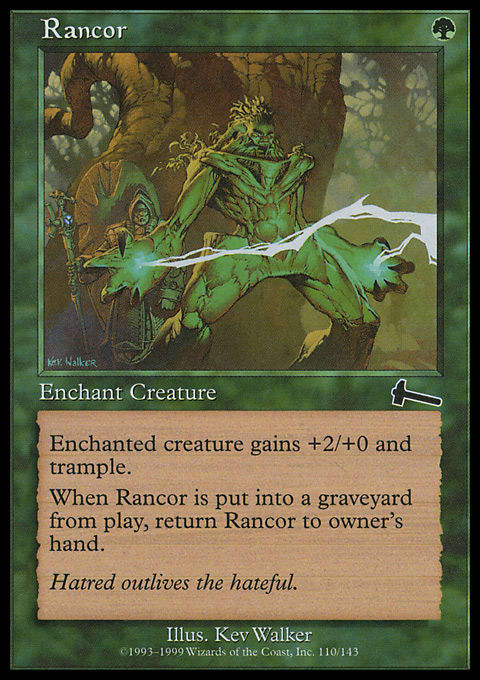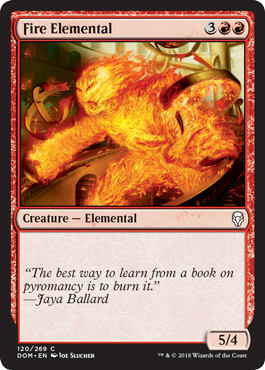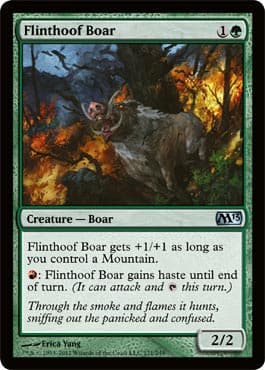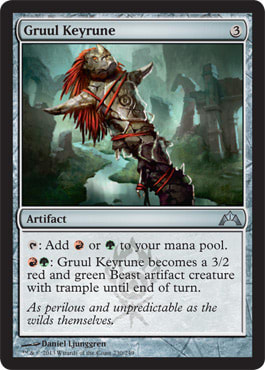Welcome to another edition of GatheringMagic's Meddling Intro Packs series! Today, I'd like to begin by addressing one of the recurring themes I've been hearing in the comments for the series: the spirit versus the letter of "budget." Unless you're joining us for the first time, you may recall that there are two golden rules we follow to keep the decks easy to assemble in terms of cost and availability. First, I limit the cards I add to commons and uncommons, passing over the typically-more-expensive rares and mythics. Second, I only draw upon sets already represented in the deck. For Gruul Goliaths, that means Gatecrash and Magic 2013. If you have some great Return to Ravnica cards you think would be a perfect fit for the Gruul, by all means indulge! This series is meant to be a journey, not the destination!
With that in mind, let's next look at the card that's caused the controversy: Rancor. This humble uncommon from Urza's Legacy sat on the shelf for many a year until it was dusted off to terrorize some casual releases (Duel Decks: Garruk vs. Liliana and Archenemy). Now that it's back in Standard thanks to Magic 2013, it's a card not unlike Lightning Bolt: an easy one to include in most any deck that is running the right color of mana. Sure, Rancor needs creatures as well, but the solid return on investment along with the ability to offset the natural card disadvantage of Auras makes it a green-mage gift missing only the bow.
It's a superb card, but for our purposes, it is perhaps a victim of its own success. As of the time of writing, Rancor is charting at an impressive $4.49, a price tag that evokes memories of Path to Exile as an all-star uncommon. Although as an uncommon Rancor is perhaps easier to open out of a booster pack, there's an argument to be made that a bulk-price rare like a Rubblehulk might be more in the spirit of budget than Rancor. I can definitely see both sides of the argument, and in the spirit of healing this terrible divide, I'm going to make a bold pledge to use no more than two Rancors for today's Meddling.
I say this with tongue planted firmly in cheek, but it's actually harder than it looks! Today's guild is the Gruul, and if ever there were a guild that wouldn't be content to leave the issue at just a pair, they’re the one. Loads of attacking creatures? Massive combat trick power-pumps? That has trample and +2/+0 written all over it, but let's see what else might be out there to give our wild and untamed R/G friends a shot in the arm. Here's the stock deck list to see what we have to work with.
"Intro Pack: Gruul Goliaths"
- Creatures (24)
- 1 Arbor Elf
- 1 Duskdale Wurm
- 1 Foundry Street Denizen
- 1 Ghor-Clan Rampager
- 1 Gruul Ragebeast
- 1 Primal Huntbeast
- 1 Ripscale Predator
- 1 Rubblehulk
- 1 Scab-Clan Charger
- 1 Skarrg Guildmage
- 1 Skinbrand Goblin
- 1 Slaughterhorn
- 2 Centaur Courser
- 2 Disciple of the Old Ways
- 2 Fire Elemental
- 2 Ruination Wurm
- 2 Viashino Shanktail
- 2 Zhur-Taa Swine
- Spells (10)
- 1 Pit Fight
- 1 Predator's Rapport
- 1 Volcanic Geyser
- 1 Ranger's Path
- 2 Ground Assault
- 1 Alpha Authority
- 1 Verdant Haven
- 2 Gruul Keyrune
- Lands (26)
- 12 Mountain
- 13 Forest
- 1 Gruul Guildgate
Cards We Cut
As we've seen with the other Intro Packs, these decks take the core of a theme or strategy and then adorn it with some singletons, curveball cards, and vanilla creatures to make it a little more accessible for its target demographic: the new or returning player. That's great, but for our purposes, we want to start chiseling away anything deemed surplus to requirements. That means cards that offer muscle and little more are receiving their pink slips. Sorry, Centaur Courser . . . farewell and adieu, you Elementals of Fire. Take the Ruination Wurm with you too, please.
Next on the block are those creatures that do offer a little bit more than just a pulse but that maybe aren't quite giving us what we need. The Duskdale Wurm has a pleasant size alongside its trample, but at 7 mana, it's a hard one to play without a dedicated ramp suite—which we won't have. The Foundry Street Denizen is a clever creature with the ability to ratchet up its power, but it's more at home in a Goblins shell, where it can squeeze the most out of its party trick. The Disciple of the Old Ways is a Bear with a bonus, but sadly for her, she comes at a slot in the curve that's already loaded with options.
The Primal Huntbeast and Ripscale Predator are also headed for the bread lines, and a few of the bloodrush creatures will be sent to keep them company. The Scab-Clan Charger is the most obvious offender, with its mana cost largely accounting for a high toughness in a deck that more highly values power. The Skinbrand Goblin is reasonably priced, but it just doesn't pack enough punch to earn a spot on the bench. Finally—perhaps the unkindest cut of all—we say adios to the Gruul Ragebeast. It's always painful to cut out a rare card, and the Ragebeast is an absolute blast to play. That said, it's a very expensive card that will typically enter play when your hand has seen most (if not all) of your creatures already wade into the fray on the battlefield. Since we'll be easing back on the mana-ramping a touch, we're not going to want to have too many games in which uncastable cards languish in hand. The Rubblehulk, by way of comparison, isn't a boat-anchor in your hand if you happen to falter on developing the mana base. It makes a lovely fat creature later in the game, but it can always be used much more cheaply through bloodrush as necessity dictates.
Unite the Clans
Those are some deep cuts, but there's still plenty to work with given a few new faces. First is the Arbor Elf. We kept the one copy and will be adding one more. This isn't an ultra-aggro build that wants to frontload its output. Although the Gruul will be quite happy to outrace slower-footed foes, it has a midrange presence that allows it to go from strength to strength. As a result, we don't need to go all-in on ramp and instead can stick with the pair—they'll be useful at most any point rather than something we're desperate to see on turn one.
To bolster the deck’s early-game presence and to give it some extra lethality, we'll also be adding a pair of Wasteland Vipers. As a 1-mana 1/2 with a nifty trick, these are very solid here, but they have an added level of synergy with the deck's core strategy. Trample is going to be playing a central role in the deck, and not just on account of the Rancors either. Thanks to the interaction between deathtouch and trample, you can push through quite a bit of damage by using the Viper's bloodrush on a trampler since only 1 point is needed to kill the opposing blocker. And should you find yourself on the back foot, a cheap deathtouching defender can help buy you some time to steady yourself.
Speaking of trample, we'll start off our look at the deck's 2-drop options with the Skarrg Guildmage. The Guildmage is quite strong here with two very useful abilities. For 2 mana, he'll give all of your creatures that all-important trample to ensure that not a point of damage is wasted. For 1 more mana, he'll give a new purpose to any extra land you might have lying about, keeping your creature count high.
Next, we'll be adding in full play sets of two more all-stars for the Gruul, the Burning-Tree Emissary and Magic 2013's Flinthoof Boar. The Emissary is rightly catching eyes in Constructed play due to her ability to replace whatever mana you've spent to cast her, giving you the promise of some very explosive starts. You could do worse than to spend that rebate on the Boar, which will almost always be an above-the-curve 3/3 when played. The option of some extra haste doesn’t hurt either.
After a bulge in the mana curve at the 2-drop slot, we'll only be dropping in a trio of Slaughterhorns for the 3-drops. The Slaughterhorn is slightly below the curve in both body and ability, though combined, it is more than enough to give it a spot in the starting rotation. We'll also be upping our quota of Ghor-Clan Rampagers. They don't come much better for the deck than this guy, a 4-mana 4/4 with trample that offers a powerful boost for only 2 mana. One of the dangers of a creature deck that runs a lot of larger beaters is that cards in hand are essentially dead until later in the game. Bloodrush gives you the best of both, and we'll go with full set of these.
From there, we'll hit the top of our mana curve, where the Rubblehulk and Zhur-Taa Swine lurk. Both are cut from similar cloth, offering (potentially) massive bodies alongside bloodrush, but with no other bells or whistles. Sometimes, though, size is enough, and when you need a way to power through that last Lava Axe's worth of damage, you could do worse than to bloodrush one of these two beaters. By the same token, having large closers at the end of the mana curve to do their grim work in the red zone is also very handy.
Rebuilding the Support Suite
This is often where the most radical overhauling is done, for although Intro Packs tend to heavily favor creatures, the noncreature support suite tends to consist of a little-bit-of-everything approach. I typically eject the lot and then look to provide a consistent core that backs up the deck's primary strategy. For the relentless creature assault Gruul Goliaths needs to win, that means some removal and a few creature augments. Worth noting here, though, is that I'll also be retaining the services of the Gruul Keyrunes. Although these aren't auto-includes in every deck (appearances in these Intro Packs to the contrary), they make a lot of sense here. Not only do they give you a touch of ramping, but the creature they activate into is a nicely-sized trampling one.
The first thing we'll do is add some removal. We don't want a ton of space devoted to creature-solving since our bloodrush will largely sort that out for us. Still, there will be the occasional Guildmage or other nuisance creature that prefers to inconvenience us from a distance instead of getting its hands dirty in the red zone, so we'll take a pair of Pit Fights. Also, a set of Searing Spears slots right in as well—they can both kill off creatures and burn out a mortally wounded opponent.
Next up are the Rancors. As promised, I'll only be putting in a pair of them, so what looks good to replace the other two? Why, Madcap Skills, of course! Although there's always a risk when running Auras, Skills can present your opponent with no small difficulty when looking to block your assault. This will often draw your opponent into overcommitting on defense to stop your creature, leaving you free to either two-for-one him by pumping your Skills-enchanted creature or simply pumping one of the unblocked creatures to set up the win. This gives us a good level of support for your creatures without having to fight for space in the deck.
To the Death!
To test the deck, we put it up against Dimir Dementia, recreating the playtest match on Ertai's Lament. In the original match, I found that the Gruul deck, while effective and fun to play, had a lot of demands upon its mana base. Having cut out a lot of the fat, could the leaner Gruul punish the secret guild even more?
Sam and I took turns playing the new Gruul Goliaths, and the only time the Dimir managed to prevail was when the Gruul couldn't find a red mana source to save its life (literally). That misstep aside, it turned in an absolutely dominating performance that denied the Dimir of that one commodity the deck covets above all others: time—time to build up, time to bog down the red zone, time to bring its card-advantage engine online.
The deck consistently opened with a 2-drop, with the Flinthoof Boar turning in a superb shift every time. Interestingly, most games were decided on the backs of the smaller creatures: the Boars, Emissaries, and Slaughterhorns attacking en masse backed up by surgical bloodrushes rather than the board being dominated by a towering fatty. Madcap Skills was difficult for Sam to find an answer to, as it gave her the devil's dilemma of losing more than one creature versus letting a high-power nasty through her defenses unscathed. In the end, the meddled Gruul Goliaths was just too much to hold off.
Here's the final decklist.
"Gruul Goliaths II: May the Tribe Increase"
- Creatures (24)
- 1 Rubblehulk
- 2 Arbor Elf
- 2 Skarrg Guildmage
- 2 Wasteland Viper
- 2 Zhur-Taa Swine
- 3 Slaughterhorn
- 4 Burning-Tree Emissary
- 4 Flinthoof Boar
- 4 Ghor-Clan Rampager
- Spells (12)
- 2 Pit Fight
- 4 Searing Spear
- 2 Madcap Skills
- 2 Rancor
- 2 Gruul Keyrune
- Lands (24)
- 13 Forest
- 9 Mountain
- 2 Gruul Guildgate
As always, your mileage may vary. Anything I missed that you'd want to see in the deck? A different way you'd have gone with the Gruul? I'd love to hear about it in the comments below!
Jay Kirkman






























